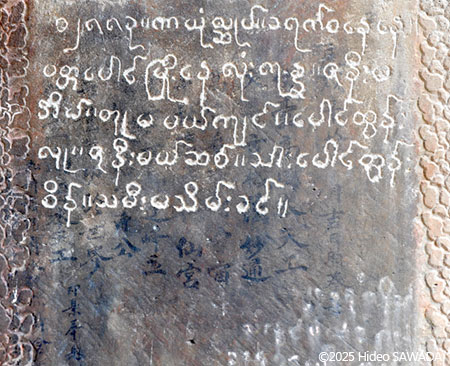Photos taken by ILCAA staff and associates are posted here once a month; most of them are taken during their field research in Asia and Africa.
(The copyright belongs to the photographers.)
Graffiti Overwriting Graffiti

Angkor Wat, one of the most famous Buddhist temples in the world, attracts countless worshippers and tourists from all over the world. Regrettably, it has also been subjected to an abundance of graffiti. Even a quick look at images online shows graffiti in a various scripts, including Latin (Western languages and Vietnamese), Khmer, Chinese, Thai, Tamil, and others, as well as drawings. The Burmese graffiti seen in the photo has also been introduced online.
This graffiti was engraved on one of the pillars of the second gallery of Angkor Wat. It is dated Saturday, the first day of the waning moon (the day after the full moon) in the month of Kasong (around May in the Western calendar), 1288 ME (1926 CE). It also includes the names of seven people: Lon Konna (the latter half of the second line, up to the punctuation ||), a man living in Battambang (a city in western Cambodia), his wife and niece, another man and his wife and two children. The first person's name is interesting because it is a combination of a Burmese or Shan-like first element (as evidenced by the tone mark :) and a second element of unclear origin, distinct from the obviously Burmese names of the rest.
Closer inspection reveals that this graffiti was engraved over another Chinese graffiti in black ink. The year date at the beginning of Chinese graffiti probably refers to 1850 CE or earlier, judging by the fading of the ink. The Burmese graffiti engraved over the older one looks as if saying, "Who cares about graffiti in a language I can’t read?" Though both graffiti equally mar this incomparable cultural heritage, I cannot help thinking that engraving one's name is even worse in that it causes indelible damage to the monument.
November 21st, 2008
Angkor Wat, Siem Reap, Cambodia
Photograph by Hideo SAWADA
Copyright © 2010 Research Institute for Languages and Cultures of Asia and Africa. All Rights Reserved.
